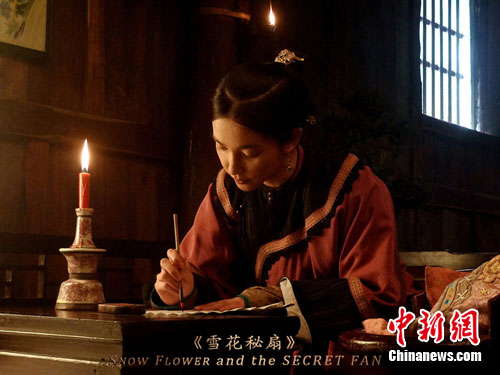(Ecns.cn)--In 19th-century China, seven-year-old girls Snow Flower and Lily are matched as laotong, or "old sames," meaning they are bound together as friends for eternity. After being separated by their families, they furtively communicate with each other by taking turns writing between the folds of a white silk fan in a secret language.
This is part of the story in the movie "Snow Flower and the Secret Fan," screening this June worldwide. Inspired by the bestselling novel with the same name by American writer Lisa See, the film is a timeless portrait of female friendship and it opens a new window onto women of the past and brings a hidden language on display.
The hidden language
In the movie, the hidden language Snow Flower and Lily use to communicate is called Nüshu, or "women's writing." This secret script is actually a real writing form that has existed in China for over 400 years.
In feudal China, women, usually with bound feet, were denied educational opportunities and condemned to social isolation. But there were always exceptions, and women in Jiangyong County, a small agricultural region located in southeast Hunan Province, remarkably developed a secret written language.
It is a syllabic script created and used exclusively among women who often embroidered the script onto cloth or wrote it in books and on paper fans, so as not to be discovered by men, especially their husbands.
Some Nüshu characters are taken from Chinese characters, while others appear to be invented; but all are rendered in a style much more cursive than written Chinese. They are thinner than common Chinese characters, which tend to be more square-shaped. But like Chinese, Nüshu is written from top to bottom in columns, and the columns are written from right to left.
Its characters took the shape of a rhombus, and were higher on the right part and lower on the left part. According to linguistic research, Nüshu had more than 1,000 characters with "no spoken counterparts," among which 80% were created based on Chinese characters, and only 20% were coinages with unknown origin.
Secretly fading away
Nüshu is believed to have been invented by a young girl from Hunan Province, who was chosen to be the emperor's concubine in the Ming or Qing Dynasty and thought she would live a life of privilege. But she was hardly prepared for her loneliness or the palace intrigues that surrounded her.
In order to write truthfully to her mother and sisters back home about her experience, she invented the code.
For a long period of time in China, women were believed to be inferior. Men disregarded this new script, and it remained unknown for centuries until the 1960s when Nüshu caught the attention of Chinese authorities who suspected that this peculiar writing was a secret code used in international espionage.
During the Cultural Revolution (1966-1976), Nüshu was listed as an evil feudal leftover and a lot of historical materials containing the script were destroyed. Women who had Nüshu knowledge were seized and condemned. Even after the cultural nightmare, some who knew the script seldom mentioned it for fear of being arrested again.
Since the beginning of the 20th century, schools were built for both boys and girls. Women were then allowed to be formally educated and learn Chinese, which led to the consequence that fewer and fewer women learned Nüshu after this formal education began.
In 2004, China's last inheritress of the mysterious Nüshu language, Yang Huanyi, died in her 90s at her home in Jiangyong County. Her death was a great loss for linguists who value this writing form.


















